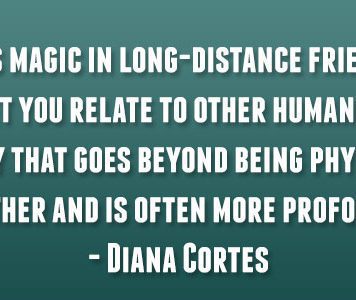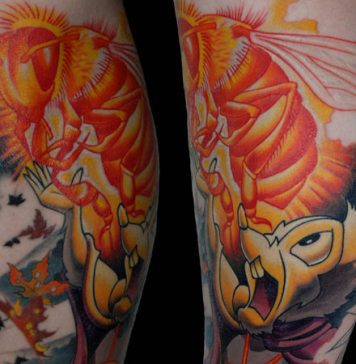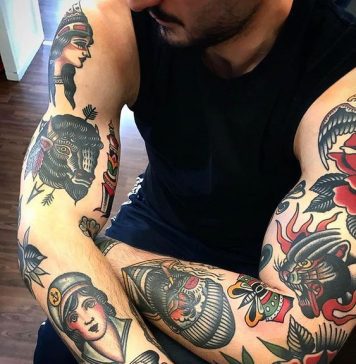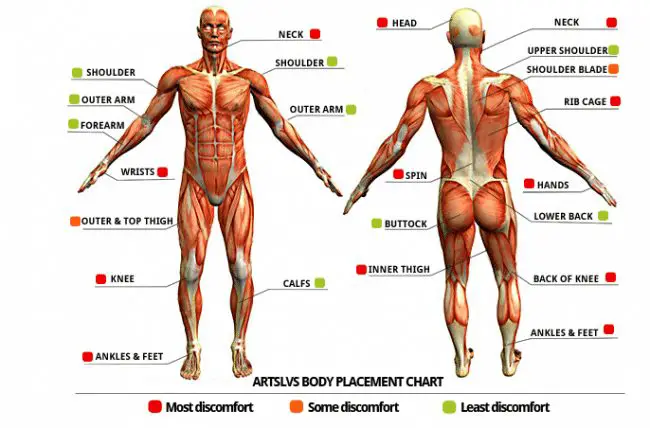
Everyone is most likely aware that getting inked is painful. But how painful? Before getting a tattoo, it’s essential to understand the science behind the process. Based on statistics, Americans spend more than $1.6 billion every year on tattoos. This data might seem surprising since people will typically avoid anything that might involve pain; however, it appears that they are able to bear the pain caused by a tattoo needle.
Tattoos are indeed painful, because the individual receives multiple micro-wounds on the skin (it will still be painful regardless of which part of the body you will put it on). Some body parts are more delicate than others; hence, we need some guide to know which areas in our bodies hurt most – this is where a tattoo pain chart becomes useful.
If you have been planning to get inked but is concerned about the pain, then you should learn to calm yourself and get rid of the fear. The tattoo pain chat will show the extent of discomfort you will encounter, depending on the area where you intend to have the tattoo.
What Tattoo Pain Feels Like
The location of the tattoo and how you perceive pain can largely affect how painful the tattoo will be. However, there is no scientific evidence yet, but it is known that there are types of pain which are common in the tattoo community.
There are common sensations that occur during the tattooing process. If you familiarize yourself with these sensations, it can help you get an idea on what to expect and how to determine if the pain is not normal.
Some individuals described the pain to be similar to a piercing sensation while others stated that it feels like being scraped or getting stung by a bee. A tiny needle is used to pierce the skin; hence, one can anticipate a piercing sensation. As the needle gets nearer to the bone, you may even feel a harrowing vibration.
Furthermore, there are various perceptions of pain. For example, the feeling of getting a cut is different from a bruise. Depending on the location of the tattoo and the pain tolerance of the person, people may experience different intensities of pain. The first five minutes is typically the most difficult, after this the body begins adjusting to the pain.
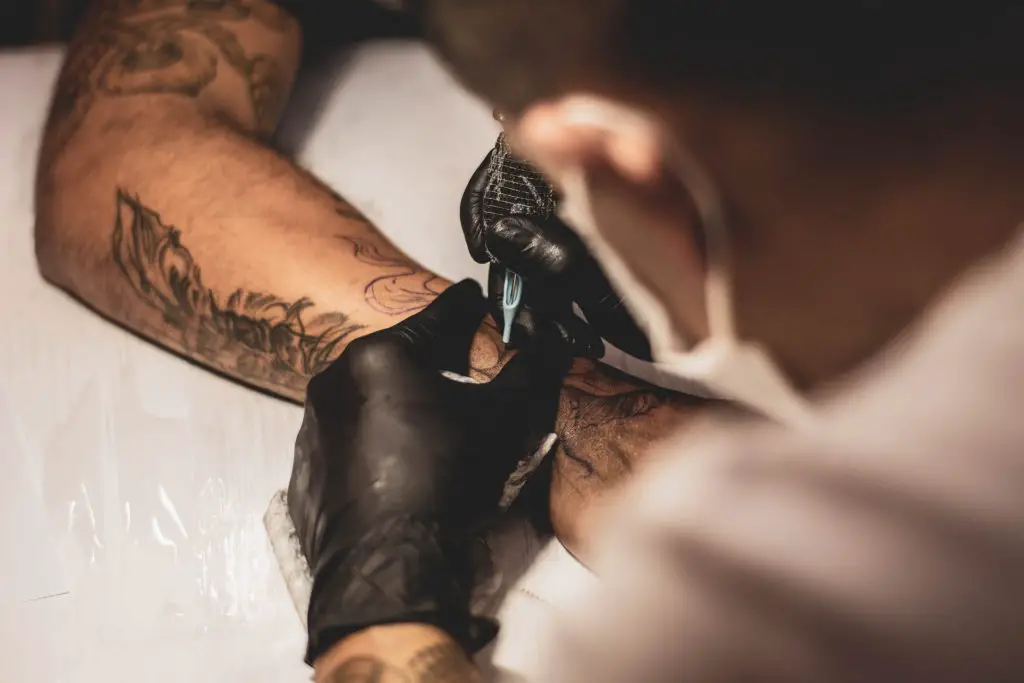
How Much Will it Hurt?
If the tattoo is big or intricately detailed, the pain may turn extreme again as the tattoo is near completion, when stress- and pain-diminishing hormones (known as endorphins) decrease.
Sensitive Nerves throughout the Body
Bundles of nerve endings can be found in different parts of the body; these are very sensitive nerves. These bundles of nerves can be found in the solar plexus, nipples, throat, hands, face, and the genitals. Furthermore, bonier parts are more likely to be impacted by the tattoo needle.
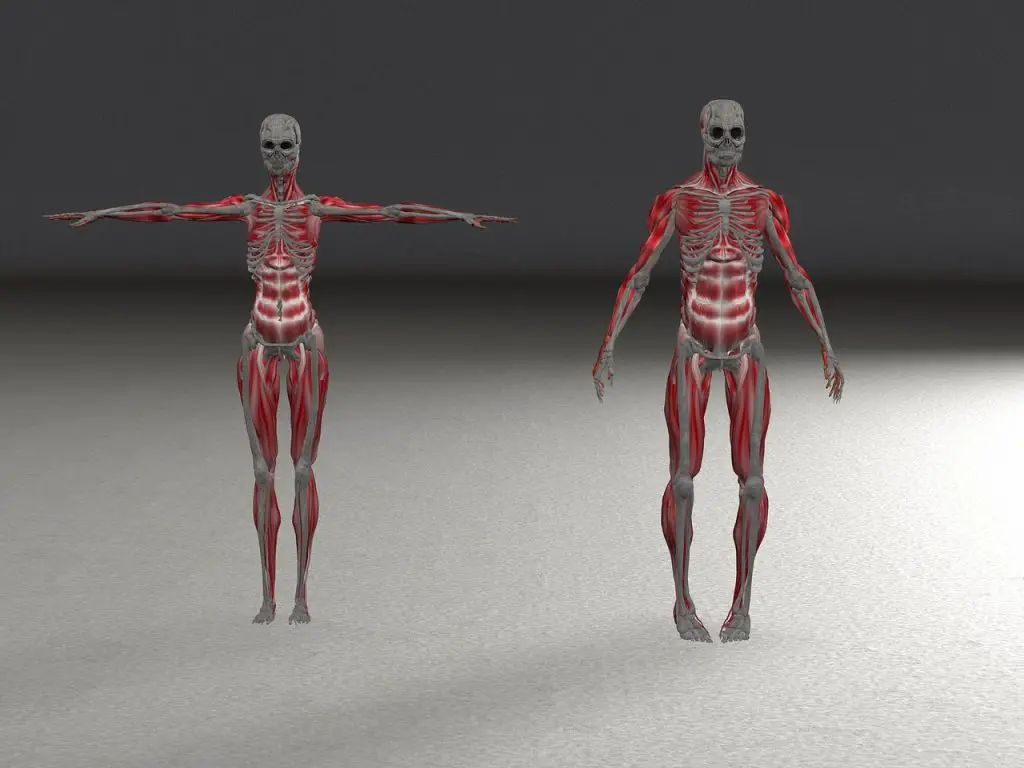
Factors That Affect Pain
Tattoo artists use needles to inject the ink into the dermis layer of the skin. This tattooing method is permanent; however, there are ways to remove the ink, such as laser treatment.
The application of tattoo ink into the dermis layer damages the skin and triggers the formation of blood clots (bruising). The person must take very good care of that particular body part to avoid infections.
After the tattooing procedure, the skin swells up – it is a natural mechanism that protects the skin from further damage and it also helps with healing. However, the swelling causes the affected area to become tender and painful.
Other methods of tattooing, such as decal temporary tattoos and henna tattoos, do not hurt. They are not permanent tattoos.
Several factors affect pain in tattooing and these include the following:
Type of tattoo
A lot of people say that outlining is the most agonizing process of tattooing. Hence, a tattoo with a bigger outline is likely to hurt more compared to a smaller tattoo made on the same body part.
Furthermore, for color tattoos, artists may need to go over one spot with the needle a few times.
Sex of the person
This factor has conflicting evidence – one study stated that women report greater pain severity compared to men after intrusive procedures. However, another study on chronic pain revealed that women have higher tolerance to pain compared to men.
Skin sensitivity
Certain people have more sensitive skin. These individuals are likely to feel more pain from tattooing.
Experience
There is a chance that you already have a higher tolerance to pain if you have been tattooed before. This is because you have adapted and has become more familiar to the pain of tattooing.
The technique of the artist
A skilled artist knows when to slow down, He/she should also know when to take a break.
Anxiety or stress
A study tried to determine if pain can be affected by stress and anxiety in men. It was found that stress increases pain severity. Thus, it can be deduced that a tattooing procedure will feel more painful when the individual is under great stress.
Take deep breaths while undergoing the procedure. Request the artist to pause if you feel unbearable pain.
Body part where the tattoo is placed
Some parts of the body are more painful for a tattoo compared to other body parts. So if you want to experience less pain, choose a spot that hurts the least.
Shape, size, and design of the tattoo
Some individuals say that sketched work hurts more compared to the shading of color. Some think that coloring and shading work is more painful. It depends on the tolerance of the person to pain.
Some experts have stated that men and women go through different pain processes. Unfortunately, there are no studies that explored that tattoo pain.
The biological interpretation for this distinction is still unclear.
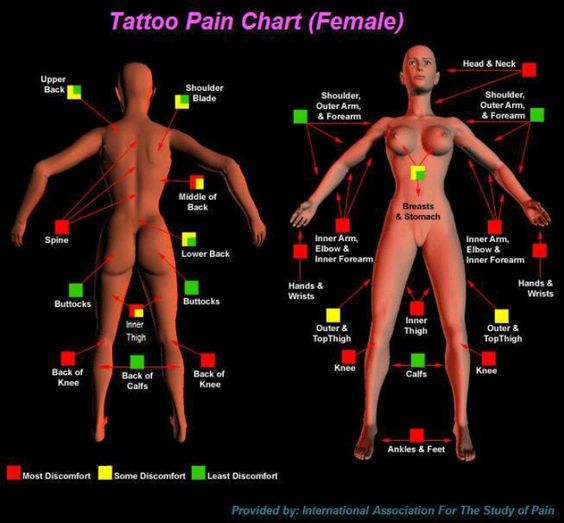
Most Painful Parts of the Body
Tattooing areas that are near the bone or have plenty of nerve endings is more painful compared to other parts of the body.
Back of Knees
The back of the knees is a painful area for tattooing because it has loose and supple skin. If you choose to get tattooed somewhere with loose skin, there is a good chance that the level of sensitivity is higher compared to getting tattooed over tight skin. It is because there are plenty of nerve endings at the back of the knees, which can be poked by the tattoo needle and trigger grievous pain.
Ribs
The ribs are surrounded with very thin skin; hence, putting on a tattoo near the ribs can cause a lot of pain, particularly if you do not have plenty of upper abdominal fat or if the ribs are prominent. Also, the rib cage moves as you breathe which intensifies the painful sensation due to the constant movements.
Stomach
The stomach is also a painful part to get tattooed because the skin is very soft and stretchable. Also, people have different body shapes which affects the severity of tattoo pain. A person with flat stomach will experience less pain than people with higher body weights.
If you want to get a tattoo on the stomach, it is recommended to abstain from food before to the procedure.
Hips
Hip tattoos are popular among women. Getting tattooed along the hip bone often looks appealing.
Since the hip bones are near the skin, this part is also a painful spot for a tattoo. Nonetheless, the body will produce adrenaline which will help you regulate the pain, if in case you still want to go ahead with the procedure.
Face/Head/Ears
Tattoos on the face, head, or ears is harder to conceal; these are also unpleasant spots to get tattoos.
The face has several nerve endings that can be irritated during the process. The facial bones are also near the skin since the face only contains a small amount of fat that will serve as cushion. Tattooing the ears is also very painful for the same reason.
Neck
Getting a tattoo in the neck is painful since there are big nerves located at the back and the sides which can be traumatized because of the movement of the tattoo needle. You might even experience pain radiating from the neck into the back (since the cervical nerve is located in the neck).
Neck tattoos are not advisable to people with low tolerance for pain.
Lips
The lips and philtrum area can also be tattooed (for permanent makeup) but this is not advisable since it is very painful. The lips have very thin skin and have plenty of nerve endings. Also, the bleeding can be intense compared to other areas. After the procedure, you will look like you have been punched in the mouth due to the swelling and bruising of the lips.
Near the Spine
Spine tattoos are very popular since these make people look more appealing and attractive. However, the spine is one of the most painful areas to have tattoos. Several nerves can be found near the spine and the skin is located near the bones; thus, you will feel like the artist is striking the bones with a hammer.
Fingers/Palms/Toes
The fingers and toes are common areas for tattoos; but these are also painful spots. There are a lot of nerves in the hands and feet that can be agitated which can trigger painful spasms. The skin is also thin in these areas.
It can also be difficult to achieve an accurate tattoo on the fingers and toes since these parts are small and curved.
Top of Foot
The tops of the feet are delicate thus it can be a challenging location to place a tattoo. Similar to other body areas mentioned above, the top of the foot has many nerves that will elicit pain from the tattooing process.
Moreover, this area is particularly lean. If you have decided to get a foot tattoo, be ready to have frequent touch ups. The artist may have to re-do the process a few times to make the image look more splendid.
Kneecap/Elbow
The kneecap and elbow area have bones that are near the skin. The vibrations on the bone due to tattooing can be painful.
Armpit
You should never consider an armpit tattoo if you have a low threshold for pain. A lot of people have claimed that it is most painful part for a tattoo. There are plenty of nerve ending and glands in the armpit; the skin is also very delicate in this area.
Inner Bicep
The inner bicep muscle helps reduce the pain from tattooing. However, the skin is quite soft and not that firm. A tattoo in this area may take a while to heal compared to tattoos in other parts.
Shin
The bones in the shin are found just underneath the thin skin layer.
Ankle
A tattoo on the ankle is very painful. The ankle bone is located just below a thin skin layer and if you do an ankle tattoo, the pain that you will feel can be as bad as having the ribcage tattooed.
Groin Area
The groin area has several nerve endings that can be traumatized while in a tattoo session. Just remember that it will cause pain more that you believe it will.
The parts of the body that have fewer nerve endings, thicker skin, and a bulkier fat layer are the least painful parts for a tattoo. It is the reason why that area that you select for your tattoo is very significant.
Shoulders
This is the most common area for tattoos, especially for tattoo newbies. The shoulders have few nerve ending and the skin in this area is also thicker than other parts, thus it will be less painful.
Upper/Outer Thigh
The upper outer thigh is one of the best locations for a tattoo. Its fat layer has the ideal thickness, with very minimal nerve endings. It is also very easy to hide tattoos in the thigh if needed. It is a relatively large area of the body, thus large-sized images are good for this part.
Upper and Lower Back
The back is one of the biggest areas of the body thus many people prefer to have their tattoo on this area because it provides serves as a huge canvas for the tattoo art.
Tattoos will be less painful here but the pain may increase as the artist gets closer to the hips and spine.
Also, the pain you will feel may also vary depending on your body shape. For instance, a person with a curvier body will likely have more fat in the lower back compared to slimmer people. Thus, if you are thin, you will probably feel greater pain since the needle can get closer to the bone.
Forearm
The forearm is also a good area for your first tattoo since it has plenty of muscle and skin, and with fewer nerve endings. It is an ideal location for average-sized tattoos with complicated designs because it will not be too painful when the artist needs to add the smaller details of the design.
Forearm tattoos can also be a good conversation starter since it is highly visible; you’ll be able to converse effortlessly with like-minded people.
Outer Bicep
The outer bicep will hurt a little bit less due to the large muscle. If you would like to show off your tattoos, you can do so since this part is quite visible.
Calf
Calf tattoos are also recommended for first-timers. The calf has few nerve endings beneath the skin, and has plenty of muscles and fats. A tattoo on this part is certainly a better choice than an ankle tattoo, for instance.
The calf has a huge, smooth surface. Hence, it is an ideal spot to get bigger tattoos or tattoos that have intricate designs. You will not feel too much pain in this area even if the artist has to go over the skin a few more times.
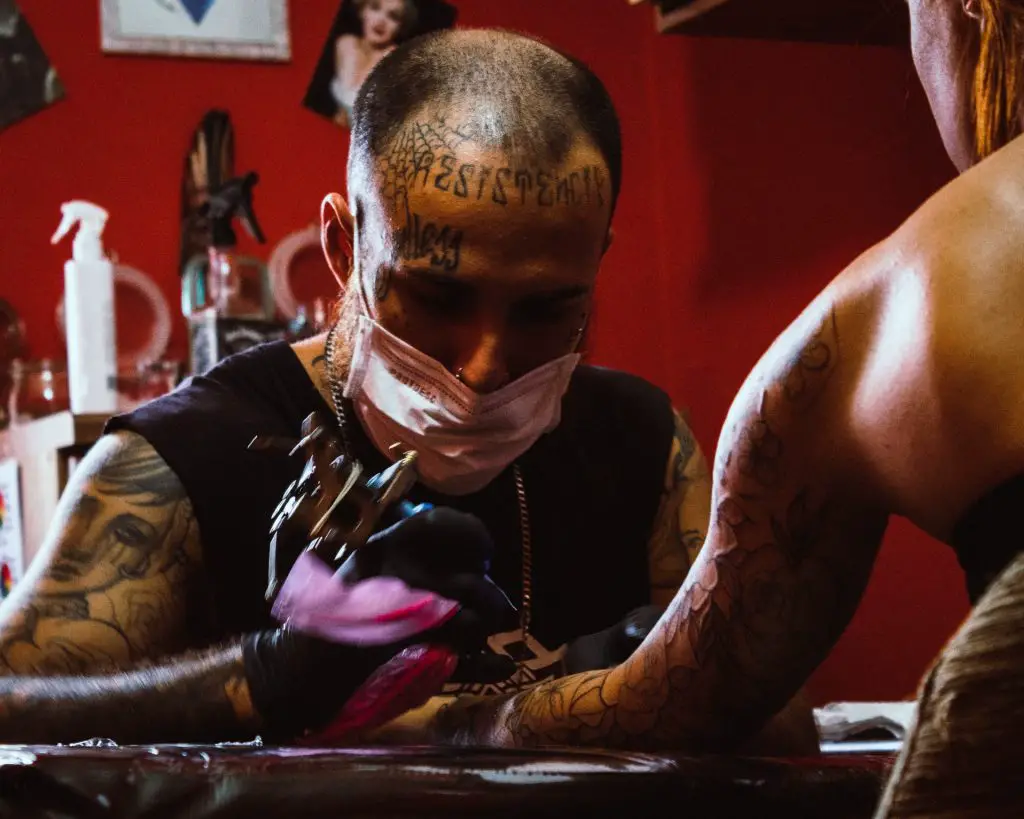
Handling Tattoo Pain
There are plenty of ways to manage tattoo pain, from conducting a quick study to using a good numbing cream. These are effective methods to make your tattooing experience less painful. It is usually the little things that will aid you throughout the process.
1. Plan the Placement of your Tattoo
Some areas are painful than other. If you prefer a less painful experience, you should consider avoiding the most painful areas for tattooing.
2. Discuss it Out
Thinking about the pain (even before a tattoo procedure) can already stress you out, thus you need to prepare yourself mentally. You should try talking to tattoo artists or friends who got tattoos. Ask them about the pain and other things to expect during the session. If you know what to expect, it will certainly calm you down and make you less scared.
3. Think About the Type of Tattoo
A tattoo with various colors or a large one often takes longer time to finish. If you are anxious about the procedure, you may opt to go with mono-shaded line art.
4. Think About the Size
First-timers should probably begin with a small tattoo instead of the full-on tattoo sleeves.
5. Mind over Matter
Some people use music, breathing techniques, and meditation to divert their minds the pain. Heck, you can even talk to your artist as a distraction.
6. Do not drink
You have probably thought of getting drunk as a way to increase your pain tolerance, but that is not a good idea. Alcohol thins the blood can lead to more bleeding.
7. Take a Painkiller
Take a painkiller before and during the procedure. However, you should be aware that some painkillers can thin the blood and trigger more bleeding than usual.
8. Follow the Instructions Given by the Tattoo Artist
You must follow a good aftercare program to guarantee fast healing. Always listen to the advice of the tattoo artist – he/she is an expert on the process and knows what they are talking about.
Always remember that you have to be calm when getting a tattoo. At the beginning of the tattooing process, the body typically attempts to reduce the pain you are feeling. The brain will start releasing endorphins (these are also released during exercise, which gives you a feeling of wellbeing). You will feel less pain when endorphins are upregulated.
However, the release of endorphins is limited and will eventually stop. Thus, getting a huge tattoo is not ideal if you are anxious about the pain.
Regardless of your choice (small or large tattoo), here are some tips that you can try to help you minimize the pain:
Sleep Enough
The body becomes weak and delicate to external stimuli if you do not get enough sleep. Restlessness can make the tattoo even more painful. Always make sure that you have sufficient sleep before your tattoo session.
Eat a Healthy Meal
Hunger will also make you more sensitive to pain (similar to being exhausted). You should refrain from eating just before the session; eat your meal 2-3 hours before. It is also recommended to have carbohydrates in your meal since carbs take longer to break down and it will provide you with a longer-lasting source of energy.
Hydrate
Staying hydrated helps maintain healthy skin. Healthy skin helps retain the ink better. Tattoo artists recommend that you begin drinking lots of water at least 24 hours ahead of the session. Make sure that you are well-hydrated until the start of the session. Drinking water can also reduce the pain.
Be Sober
Some people would opt to have a quick drink before getting a tattoo because they believe that alcohol will help them feel numb to the pain. It’s actually the opposite. Drinking alcohol before a tattoo session is not a good idea and can be outright risky.
Alcohol dilutes the blood – which can cause increased bleeding – during the process. Moreover, it will be more painful because the skin may not accept the ink well because of the extreme bleeding.
Have a Break
If you decide to put a tattoo in a sensitive spot or if you have difficulty tolerating pain, do not hesitate to ask your tattoo artist for a break. However, the break should not be too long since it may trigger swelling which could make the process more difficult. Nevertheless, a quick snack break will increase the levels of blood glucose and help you control pain.
If you feel unbearable pain and you prefer to change your position, just inform the artist. Your artist wants you to be calm so he/she can focus on the tattoo. Do not hesitate to talk to them and tell them exactly what you’d like to do.
Consider Using a Numbing Product
There are several products that are suitable for tattoos; different results can be obtained depending on the ingredients and usage of a particular product.
For individuals who wants additional help, a tattoo numbing cream will help reduce the pain.
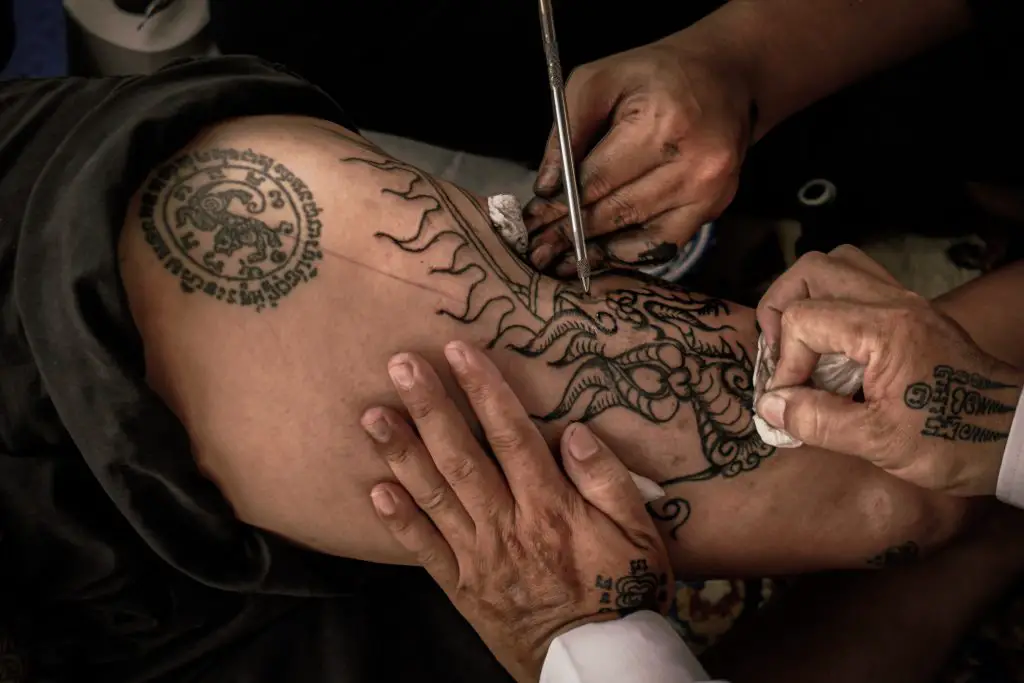
A tattoo will undoubtedly hurt regardless of the person’s tolerance level for pain. But worry not! There are steps that you can do to have a less painful tattoo session.
Bring something that would occupy your mind
Listening to music, reading a book, or watching can help take your mind elsewhere. You can do other things – the goal here is to focus your attention on something else so you will forget about the pain. Controlling your breathing can also help you calm down and allows you to finish the session more comfortably.
Again, sleeping well and eating well will also help provide a less painful tattoo session.
Be Positive
Positivity is also helpful. Start by viewing the tattoo session in an optimistic manner. Avoid thinking of negative thoughts; it will only freak you out. If you do this, you will adapt and calm down more quickly.
Conclusion
Getting a tattoo is undeniably painful for anyone. But as mentioned, several factors affect the level of pain that can be felt by an individual. Factors such as the position of the tattoo, skin condition, and sex can influence the intensity of pain during a tattoo session.
Make sure that you are aware of the problems or risks that may arise during and after a tattoo session. It is recommended for you to consult a tattoo artist first – this step will help you decide whether to get a tattoo or not.
Placing a tattoo on your body will only take a few minutes or a few hours, but the tattoo itself can stay with you for lifetime. The pain will likely be the only pressing concern you will have; getting rid of a tattoo is more time-consuming and painful.


